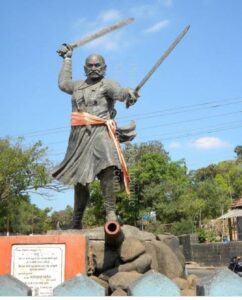
Baji Prabhu Deshpande (c. 1615-1660) was a Minister/Count (also known as Sardar) and commander for Shivaji, historical founder of the Maratha empire. The well celebrated legend of Baji Prabhu is intricately linked with an important rear guard battle enabling Shivaji’s escape from Panhala fort; he was the hero who sacrificed his life for his king and country.
Early life
Baji Prabhu was 15 years elder to Shivaji Maharaj, this means he was born around 1615. He was born in a Chandraseniya Kayastha Prabhu family.[1] His original surname was Pradhan. He was honoured by Kulkarni Hakka as per available information from modi Scripts. He was born in Shind Village of Bhor Taluka in Pune District.
Battle of Pavan Khind
After defeating Afzal Khan and the rout of the Bijapuri army at Pratapgad, Shivaji continued to push deep into Bijapuri territory. Within a few days, the Marathas captured Panhala (near the city of Kolhapur). Meanwhile another Maratha force, led by Netaji Palkar, pushed straight on towards Bijapur. Bijapur repulsed this attack, forcing Shivaji and few of his sardars to retreat to Panhala Gad (fort).
The Bijapuri force was led by Siddhi Johar, an Abyssinian general. Discovering Shivaji’s location, Johar laid siege to Panhala. Netaji Palkar made repeated attempts to break the Bijapuri siege from outside, but these failed.
Finally a very audacious and high risk plan was hatched and put into action: Shivaji, Baji Prabhu Deshpande with a select band of troops would attempt to break through the siege at the night, and make for Vishalgadh. In order to deceive the Bijapuri forces, who would give a chase once they found that Shivaji had broken the siege, Shiva Nhavi, who had an uncanny physical resemblance to Shivaji, volunteered to dress like the king and let himself be captured.
On a stormy full moon’s night (night of Guru Pournima, Ashadh Paurnima) a band of 600 select men, led by Baji Prabhu and Shivaji, broke through the siege. They were hotly pursued by the Bijapuri force. As planned, Shiva Nhavi allowed himself to be captured and taken back to the Bijapuri camp, fully comprehending that he would be put to death once the charade was discovered. This sacrifice, however gave the fleeing Maratha force some breathing space.
As soon as the Bijapuri force realized their mistake, the chase was on again, led by Siddhi Masood, the son-in-law of Siddhi Johar. Near the pass of Ghodkhind (Horse’s Pass), the Marathas made a final stand. Shivaji and half of the Maratha force pushed for Vishalgadh, while Bajiprabhu and the remaining Bandal Sena of about 300 men blocked the pass and fought with 4000 number of mughal soldiers in pavankhind. The ratio of battle was more than 1:100 and war becomes one of the biggest war of maratha empire.
Tradition and legend describe feats of valour displayed by the Marathas during this rear guard action. Through the entire battle, Baji Prabhu, even though grievously injured, continued fighting, inspiring his men to fight on until Shivaji’s safe journey to Vishalgadh was signaled by the firing of three cannon volleys. It should be mentioned that when Shivaji approached Vishalgad with 300 men, the fort was already under siege by another Mughal sardar named Surve. Shivaji with his 300 men had to defeat Surve to reach the fort.
Accolades
The Ghodkhind pass was subsequently named Pavan Khind (“Holy Pass”) (Marathi: पावन खिंड) by Shivaji, in honor of the sacrifice of Baji Prabhu and his troops. Shivaji Maharaj honoured Baji Prabhu’s family with “maanache pahile paan” (“Honor of the Court”) (Marathi: मानाचे पहिले पान).[2]
A street is named after him in Thane and Ambarnath, India, and a film based his story was made in 1929.[3] A square is named after Baji Prabhu Deshpande in Dombivali city (District Thane – Maharashtra).
Reference:
Baji Prabhu Deshpande – Wikipedia
